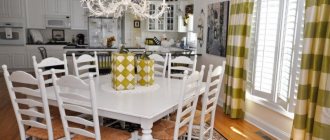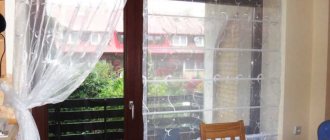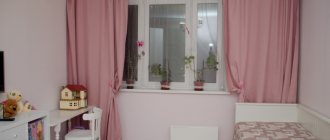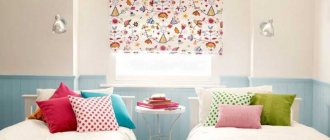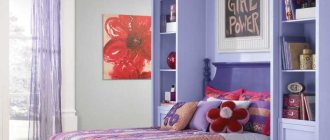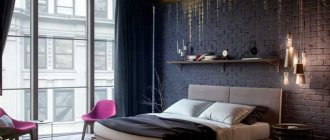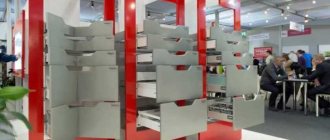Roman blinds enjoy deserved popularity due to such qualities as functionality, simplicity, elegance and versatility.
They reliably protect the room from the scorching rays of the sun, while softly scattering light around the room and serving as a real decoration of the home.
Roman blinds look great in any room of the house - living room, children's room, bedroom and kitchen. Currently, you can purchase this product ready-made, or order its production according to individual parameters.
Modern manufacturers offer a huge selection of textures, shades and shapes, so choosing the most optimal model for a specific room is not difficult. Roman blinds are perfect for the kitchen and will become an integral part of any interior.
Advantages of Roman blinds
The main advantages of this type of curtains:
- Simplicity and conciseness that fits into any interior design from strictly minimalism to luxurious empire style;
- Easy to care and wash;
- Beautiful elegant appearance;
- Convenience: opening and closing such a curtain is easy and quick, it does not require any effort;
- Ergonomics: due to the fact that Roman blinds take up little space and do not interfere with the window, the window sill can be used as an additional work area or place pots with indoor plants there.
Roman and roller blinds: comparative characteristics
| Roman | Roller blinds |
| Fabric with special inserts-rods that form even horizontal folds | Smooth one-piece fabric |
| Mounted on a cornice and folded like an accordion when lifted | Rolled up; design - open or closed with a box |
| Machine washable | Cleaning by hand only |
| Higher price | There are economical options |
| More suitable for home | Can be used both at home and for an office, store, etc. |
Advantages of Roman blinds:
- simple design that you can make yourself;
- not as difficult to care for as with roller blinds: machine washable;
- create a cozy atmosphere and look homely.
You can make a Roman blind with your own hands
The design includes the following elements:
- rectangular canvas;
- rods fixing folds;
- lifting mechanism + control chain;
- weighting on the bottom fold.
Stiffening ribs serve for proper assembly of the canvas and the formation of even folds
Mounting location
Curtains can be attached in different ways. Main mounting points:
- Frame;
- Sash;
- Wall;
- Ceiling.
The first three options are suitable for use in the kitchen, while the ceiling mount is more suitable for the living room than the kitchen.
If you decide to purchase Roman blinds for a kitchen with a balcony door, choose the option that is attached to the door rather than to the wall. In this case, you can easily and quickly open the door to the balcony, and you do not need to lift the curtain every time.
Often curtains are attached using Velcro tape. One part of the Velcro is glued to the wall or frame, and the second is sewn to the curtain with threads.
Color and pattern
Textile design does not have any strict rules, but some decisions are better to follow.
Curtains in accordance with the color scheme of the walls or furniture . This solution allows you to give the interior integrity and harmony. The combination of curtains in color with the walls visually expands the space, so it is relevant for small kitchens.
Texture combination. You don't have to choose the same tone. Curtains can be matching the texture of the furniture, or have the same pattern.
Increasing the volume of the room. This effect can be achieved with a plain light-colored fabric.
A great way to expand a space is to use white. However, it is better to combine it with other tones, otherwise the room will be devoid of comfort and will look sterile and monotonous. Therefore, if the main range of colors in the interior is white, then it is better to choose curtains of coffee, beige, pink or another color.
If the kitchen has wallpaper with a pattern or a bright color, then preferably use plain curtains. Dark colors are only suitable for large rooms, otherwise the space will be reduced.
Types of Roman blinds
- Classic. When unfolded, the curtain looks like a smooth canvas, and folds form only when the fabric is lifted. This type of curtain fits well into minimalist style interiors.
- Cascade. Cascading Roman blinds have beautiful pleats both when unfolded and folded. This option is suitable for empire, classic and country styles.
- Frame. Frame models have wooden or plastic rods arranged horizontally. Straight, neat folds are formed exactly in the places of this frame.
- Frameless. If the curtain does not have horizontal slats, then it is considered frameless. When folded, softer folds are formed, and the lower part sags in the form of a semicircle.
Types of structures
There is no need to confuse Roman and roller blinds: these are fundamentally different window design options. The latter do not form elegant folds when the canvas is lifted up, and do not look so interesting and expensive. The appearance of Roman curtains is more complex and depends on the type of construction.
Classic version
Ascetic curtains, closest in appearance to roller curtains. They represent a smooth canvas that, when folded, forms horizontal folds. Suitable for a small kitchen made in a laconic style.
Cascade designs
Preserves waves even when unfolded. They look expensive and attract attention. Suitable for a large window in a spacious kitchen-dining room. Harmonizes with styles: classic, empire, rococo, art deco. When sewing the model, a lining is used. It maintains lush folds.
Frameless Roman blinds
A model without rigid bars, imitating the shape of an arcuate grab. It assumes the simplest design: the canvas is secured at the edges with a set (rings, ropes, chains). They have a sleek, lightweight look. These kitchen curtains are easiest to sew yourself.
Fabrics
Modern Roman blinds for the kitchen are made from any fabric:
- Natural;
- Synthetic;
- Mixed ones.
Natural ones include cotton, linen, bamboo and silk. These curtains look luxurious and are suitable for sophisticated interiors. But natural materials have disadvantages: they require complex care and fade in the sun over time.
Synthetic fabrics - acrylic and polyester - are easy to care for, do not wrinkle, and are easy to wash and dry. But these materials look simpler and can deteriorate under the influence of heating devices.
The best option is mixed fabrics containing synthetic and natural fibers. These are organza and taffeta. They combine the advantages of the two previous types: elegant appearance and durability.
What curtain fabric is best to use in the kitchen?
First of all, when choosing, you need to take into account all the specifics of the kitchen. Roman lifting fabrics made of mixed or natural fabrics, such as linen, organza, cotton or silk, as well as bamboo models, would be appropriate here.
Curtain lifting mechanism
There are three types of Roman blind lifting mechanism:
- Manual - a rope is pulled through the rings on the wrong side of the fabric, which, when pulled, lifts the curtain and folds are formed. In this case, the weight of the fabric should not exceed 5 kg;
- Chain-rotor - instead of a rope, a chain is used, which drives the rotating rod and belts that raise the curtain. In this case, the weight of the material can reach 7 kg;
- Electric - similar to the previous type, but with a built-in electric motor.
Size
When choosing the size of a Roman blind, you should consider the location of attachment. If the canvas is attached to a frame or window sash, then the width should be 2 cm less than the width of the window. The edge of the straightened curtain should not reach the window sill by 1–2 cm.
- The width of curtains attached to the wall should be 10–20 cm greater than the width of the window.
- The length should be chosen so that the curtain covers the window sill.
- The curtain can be made even wider if it is necessary to hide the pipe located next to the window.
You will also have to measure the size of the window if you decide to sew Roman blinds for the kitchen with your own hands.
If you decide to order a curtain from a studio, you can simply invite a measurer, and in a few days the curtains will be made to your individual size.
Styles
When choosing Romanesque curtains, it is important to be guided by the style of the room. The following are the features of window design for different design areas.
Modern
Simplicity, clarity, rejection of flashy accessories and prints are the pillars of modern design. Laconic rising curtains made of natural materials are appropriate. Simple colors are preferred: beige, milky, brown, black, black. You should not choose fabrics with a pattern, with the exception of a thin, non-contrasting stripe.
Minimalism
Characterized by simple geometric shapes, neutral shades, natural materials. Curtains with a lifting mechanism made of plain tulle, organza, matting, or artificial linen will fit into the kitchen. Optimal colors are white, black, gray, blue, red, and sand.
Loft
It assumes a partial or complete absence of wall decoration, high ceilings, and a faded color scheme. Accent curtains with a lifting design in bright colors are acceptable: blue, scarlet, green. Laconic solutions are also suitable for the kitchen: beige, graphite, burgundy colors. It is advisable to use natural fabrics.
Provence
Light romantic style, not overloaded with accents. Cotton, chintz, and artificial linen are recommended for window decoration. In the kitchen, a print is acceptable: small flowers, small checks, stripes. The elements look great: ruffles, tassels, lace. It is better to choose a cascade type of design.
Classic
Style is based on rigor, elegance, and convenience. For the kitchen, classic cascade-type options on a frame, made of:
- artificial silk;
- organza;
- thick tulle;
- taffeta;
- thick cotton;
- brocade
Roman blinds with lambrequins
The design of Roman blinds on a kitchen window can look quite simple, so the curtain is sometimes complemented with curtains and lambrequins.
This option is well suited for a kitchen-living room if it is necessary to zone the room. For a small kitchen, it is better to limit yourself to curtains in light colors and without lambrequins.
Light transmittance
Curtains made from different fabrics may or may not allow light to pass through. You need to select them depending on the intensity of sunlight in the kitchen.
If the windows of the room face south, then dimout curtains are suitable, absorbing up to 70% of the light. Blackout curtains completely block out the light, so they are more often used in the bedroom rather than in the kitchen.
If there is little light in the kitchen space, then you can purchase translucent curtains made of light fabrics and tulle. They do not completely absorb the sun's rays, but scatter them.
On the ground floor, to protect against prying eyes, it is recommended to hang thick curtains, regardless of the light level.
Materials
Canvases can be made from fabrics of different densities: from jacquard materials to tulle. Accordingly, they will have different degrees of light transmission and different purposes. When sewing Roman blinds, natural materials (linen, cotton) or synthetic (polyester) can be used. Blended fabrics are also used, which contain several different types of fibers.
Curtains made from natural fabrics make the kitchen warm and cozy
Roman blinds can be made from non-woven materials such as bamboo.
Bamboo Roman blinds in the dining room of a private house
Striped curtains
From the photo of Roman blinds in the kitchen you can see that they can visually transform not only the window, but also the room as a whole. Horizontal stripes can make a narrow kitchen appear wider and create the illusion that the window opening is larger than it actually is.
In a room with low ceilings, curtains with vertical stripes are used to make the ceiling appear higher and the window to appear elongated vertically.
Color spectrum
The choice of colors for curtains primarily depends on the style and design of the room.
- Green. Brings a fresh and energetic atmosphere to the kitchen interior and gives it a second wind.
- Yellow. This color creates a bright, sunny and cheerful design and significantly transforms the room.
- Burgundy. The color of ripe cherries is capable of giving the kitchen a luxurious and respectable look with its splendor.
- Blue. It adds airiness and lightness to the interior, envelops it in coolness and creates a unique atmosphere.
- Beige Roman blinds are perfect for a small kitchen. They create a feeling of space.
- Brown. A comfortable and elegant color that can preserve the atmosphere of home comfort.
- Lilac. A delicate lavender shade brings calm, tranquility to the room and gives it an extraordinary appearance.
- Orange. Fills the space with sun and warmth.
The photo shows green Roman curtains with patterns in the kitchen interior.
The photo shows a small kitchen and a window opening, decorated with classic Roman blinds in beige tones.
Curtain care
Often, Roman blinds presented in stores are impregnated with special substances that protect the material from dust, bacteria and dirt.
But even without special impregnations, caring for curtains is simple:
- Once a week you need to dry clean with a brush to remove dust;
- For more severe dirt, you can clean the curtain with a vacuum cleaner using a furniture brush;
- Washing will be required once or twice a year. To do this, remove the curtain from the window, remove the frame rods and the weight plate from the bottom, and then wash it. When washing and drying, you need to take into account the properties and composition of the fabric so that the material does not shrink or stretch.
Roman blinds are a universal option for different types of kitchens. You can choose such curtains to suit every taste and any style and interior design.

